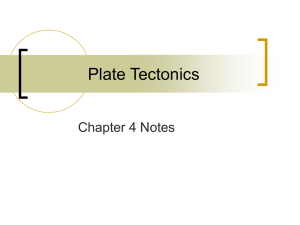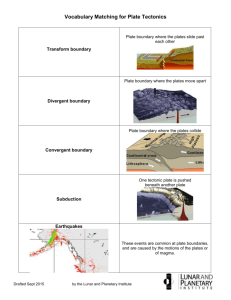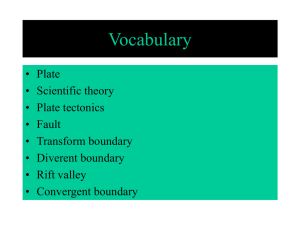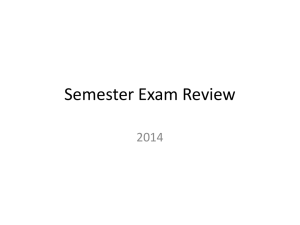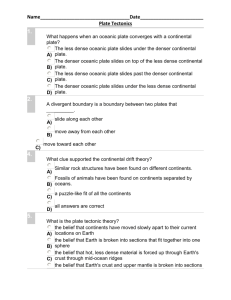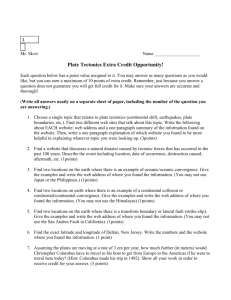Unit 3- Plate Tectonics - Thomas C. Cario Middle School
advertisement
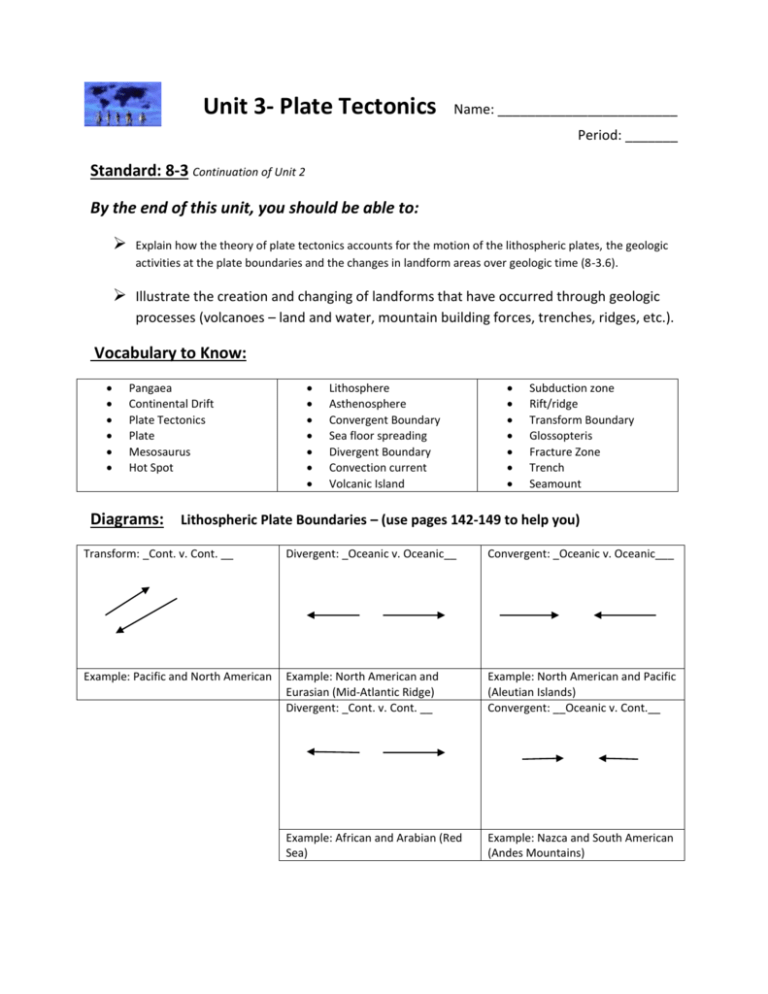
Unit 3- Plate Tectonics Name: ________________________ Period: _______ Standard: 8-3 Continuation of Unit 2 By the end of this unit, you should be able to: Explain how the theory of plate tectonics accounts for the motion of the lithospheric plates, the geologic activities at the plate boundaries and the changes in landform areas over geologic time (8-3.6). Illustrate the creation and changing of landforms that have occurred through geologic processes (volcanoes – land and water, mountain building forces, trenches, ridges, etc.). Vocabulary to Know: Pangaea Continental Drift Plate Tectonics Plate Mesosaurus Hot Spot Lithosphere Asthenosphere Convergent Boundary Sea floor spreading Divergent Boundary Convection current Volcanic Island Subduction zone Rift/ridge Transform Boundary Glossopteris Fracture Zone Trench Seamount Diagrams: Lithospheric Plate Boundaries – (use pages 142-149 to help you) Transform: _Cont. v. Cont. __ Divergent: _Oceanic v. Oceanic__ Convergent: _Oceanic v. Oceanic___ Example: Pacific and North American Example: North American and Eurasian (Mid-Atlantic Ridge) Divergent: _Cont. v. Cont. __ Example: North American and Pacific (Aleutian Islands) Convergent: __Oceanic v. Cont.__ Example: African and Arabian (Red Sea) Example: Nazca and South American (Andes Mountains) Convergent: _Cont. v. Cont. _ Example: Indian and Eurasian (Himalayan Mountains) Convection Currents – Draw a diagram showing convection occurring inside the earth. Label the following: crust, mantle, lithosphere, asthenosphere, outer core, inner core, hot, cold, more dense and less dense. 1. 2. 3. 4. 5. 6. 7. 8. 9. A B Asthenosphere Outer Core Inner Core Crust Upper Mantle Lithosphere Mantle Mountains Valley/ Seas C 10. Volcanic Mountain 11. Trench 12. Subduction Zone 13. Ridge/ Rise 14. Volcanic Island 15. Trench 16. Subduction Zone 17. Continental Crust 18. Oceanic Crust D E F Hot spots – Diagram how hot spots occur. Name an example of one: ___Hawaiian Islands____ What are hot spots? _Areas of the asthenosphere, not on a plate boundary, which have a higher temperature than other areas causing hot, less dense magma to rise to the surface.__ Describe Diagram: Magma is rising to the surface at point A from a hot spot, then over time, the plate moves in a northwestern direction and magma rises up again to form point B behind it. People: o Alfred Wegner: Came up with the Hypothesis of Continental Drift. o Henry Hess: Came up with the hypothesis of seafloor spreading. Theory of Plate Tectonics Concept Map: Combines Continental Drift Seafloor Spreading Hypothesis: Hypothesis: Continents have slowly drifted to their current location. Land is spreading and being formed at the mid-ocean ridges. Evidence Glossopteris Glacial Scrapings Mesosaurus Evidence Rock/ Mountain Clues Magnetic Reversal Age of Rocks Essential Questions: Part A) Read p. 134-137, answer some of the self check on p. 137 using the question in your answer. 1. Self Check #1 Wegener’s climate clue evidence of continental drift was fossils of warm climate plants were found on Antarctica and glacial scraping were found in Africa. This proved both land masses must have been in a different climate sometime prior. 2. Self Check #2 Rock structures, such as mountains and rock sequences, were similar on different continents which supported the hypothesis of continental drift. 3. Self Check #3 (use Glossopteris as an example) Fossils of the fern-like plant Glossopteris were found on Antarctica, Australia, India, Africa, and South America. All widely spread apart continents today. So, these fossils supported the hypothesis of continental drift. 4. Why was Wegner’s idea rejected initially (at first)? Wegner and other scientists could not explain HOW, WHEN or WHY these continents moved. Part B: Read p. 138-140, answer some of the self check on p. 140 using the question in your answer. 1. Self Check #1 The magnetic reversals recorded in iron-bearing minerals show that new rock was being formed at the ridges over time. 2. Self Check #2 The closer the rocks are to the ridge, the younger the rocks. 3. Self Check #4 The partly molten material will rise to the surface because it is less dense. It pushes the seafloor away from the ridge in both directions. 4. Self Check #5 Seafloor Spreading explains how the crust could move- something that the continental drift hypothesis could not do. Part C: Read p. 142-151. 1. Look at Figure 9. What is happening where the Nazca plate meets the South American plate? Subduction at a continental v. oceanic convergent plate boundary. 2. What type of land formations/natural disasters might occur here? Volcanic mountains, trenches, and earthquakes. 3. What two plates are to the west of the mid-atlantic ridge? North American and South American 4. What two plates are to the east of the mid-atlantic ridge? Eurasian and African. 5. What type of boundary is associated with the seafloor spreading between these two plates? Divergent oceanic v. oceanic plate boundary. 6. Look at Figure 12. Draw the two convection currents that would make a ridge. 7. Draw the two that would make a trench. 8. What current technology supports the theory of plate tectonics? Satellites and lasers. Part D) p. 156: 1-14, just write the letter for 7-14 and answer 15-21 in complete sentences. 1. Asthenosphere 5. Plate Tectonics 9. C 13. B 2. Continental Drift 6. Seafloor Spreading 10. A 14. D 3. Pangaea 7. B 11. A 4. Lithosphere 8. D 12. B 15. Few volcanic eruptions occur at the Himalaya’s because it is a continental v. continental convergent boundary. Neither plate is denser, so neither plate will subduct and melt to create volcanoes. 16. Scientists believe Africa must have once been located near the poles in order to have supported glaciers. 17. (use picture under number 23 to help you) Magnetic Reversal is shown in iron-bearing minerals at the mid-ocean ridges, since it changes as move away from the ridge. 18. Volcanoes do not form along the San Andreas Fault because it is a transform boundary. Volcanoes can occur at divergent or convergent boundaries. 21. Convection currents circulate hot material along divergent boundaries. Older seafloor is forced apart. Magma rises to the seafloor. Magma cools to form new seafloor. To Do: Unit 3 Preview _________ Introduction to the Seafloor Activity ______ Unit 3 Vocab. _________ ???Activity 42: The Theory of Plate Tectonics ______ Continental Drift Video Questions ________ Lab Journal - Activity 40: Continental Puzzle ________ ???Lab Journal - Activity 44: Mapping Plates ________ ???Mapping Quakes and Plates Lab Sheet ________ Activity 45: Understanding Plate Boundaries Chart __________ Lab Journal - Activity 41: Continental Drift _________ Why is their Lithosphere Lab _____ Plate Boundary Review/Convection Currents on back ________ Lab Journal - Activity 46: Convection Currents ___________ Activity 47: Spreading Plates and Activity 48: Other Plate Directions ________ Unit 3 Project______ Unit 3 Vocab Stations/ Crossword _________ Project Grid: Points: Pretend you are Alfred Wegner and you want to get your work published. Write a letter to the board of scientists with all of the evidence to show your hypothesis is accepted. Create a 3-D model with moving pieces to display continental drift. Include locations of all continents when in Pangaea and currently. Create a rap, poem or song about the plate boundaries and plate tectonics Points: Create a video as if you are a scientist reporting from a plate boundary location. Include key scientific information on past events and evidence of movement at that location. Create a foldable showing a cross section of the Earth. Also, include a small 3-D model to go along with it. Be sure to incorporate the convection currents. Pick a location that you would like to visit that lies on a plate boundary. Create a power point showing the type of boundary and the effects of that boundary on life at that location. Be sure to explain why you would like to live there. Be prepared to present it. Points: Create a plate tectonics board game complete with game pieces, dice, cards, time piece, and board. The game must be organized in a box and include directions for play and rules. It also must include all vocabulary and concepts discussed in Unit 3. Build a shoebox model (means that all models will fit inside a shoebox) of 5 real plate boundaries. Make sure to show the differences in geologic activities which occur at each, densities of either side of the boundary, and arrows showing movement. Also, check to make sure your plates are accurately displayed using a nearly accurate scale. Following learning about hot spots, research hydrothermal vents (geysers located on the ocean floor in the deep sea). 1. Predict – based on the plate tectonics map- where in the Atlantic and Pacific oceans they might find the greatest numbers of hydrothermal vents. 2. Create a lesson teaching the class about hydrothermal vents including a power point, a notes worksheet, and a quiz. Optional bonus project – Create a 3-D plate’s puzzle showing all plates (use p. 143). Make sure that the oceanic plates are thinner than the continental plates. Each plate should be a different color. If you choose to do this, ask Mrs. G for a map to help you size your puzzle.

